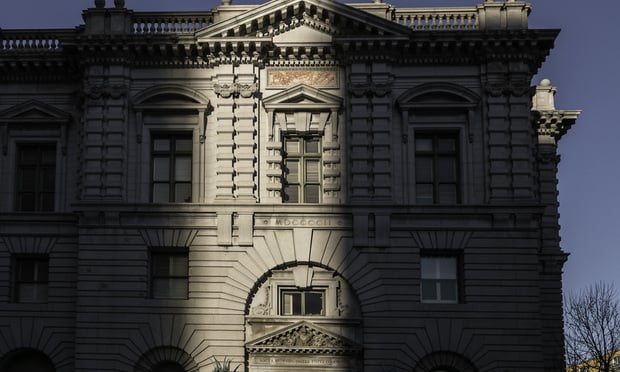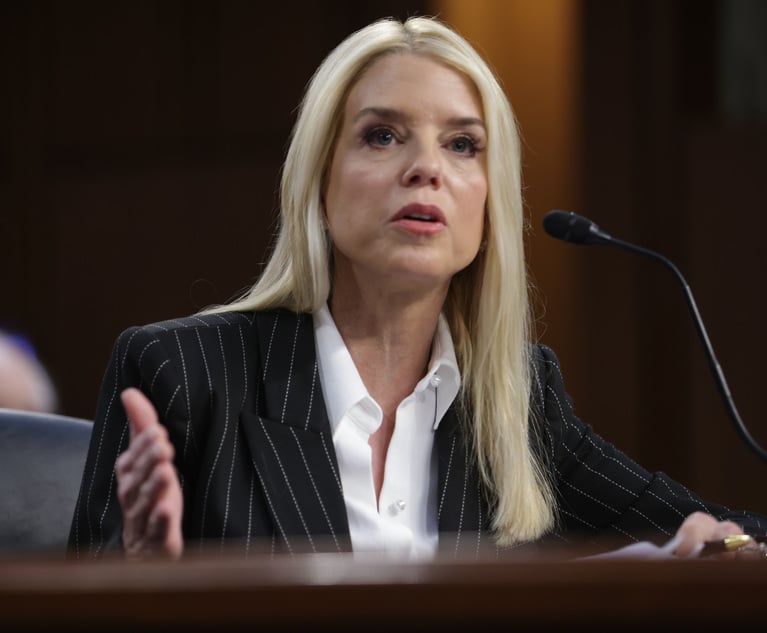House Committee to Take Up Measure to Reconfigure the Ninth Circuit
The House Judiciary Committee is set to consider Rep. Darrell Issa's proposal to divide the nation's largest circuit court into three regional divisions and one circuit-wide division at a markup hearing Thursday morning.
September 12, 2018 at 05:35 PM
3 minute read
The original version of this story was published on The Recorder
 U.S. Court of Appeals for the Ninth Circuit. Photo: Jason Doiy/ALM
U.S. Court of Appeals for the Ninth Circuit. Photo: Jason Doiy/ALM
A new proposal to reshape the U.S. Court of Appeals for the Ninth Circuit, the nation's largest and busiest federal appellate court, is set for a markup hearing before the House Judiciary Committee on Thursday morning.
The bill, introduced Monday by Rep. Darrell Issa, proposes dividing the Ninth Circuit into three regionally based divisions—a Northern Division composed of the district courts in Alaska, Idaho, Montana, Oregon and Washington's Eastern and Western districts of Washington; a Middle Division made up of the courts in Guam, Hawaii, Nevada and the Northern Mariana Islands, as well as California's Eastern and Northern districts; and a Southern Division including Arizona and the Southern and Central districts of California.
The bill, dubbed the ''Court Imbalance Restructure Concerning Updates to Impacted Tribunals Act of 2018″ or CIRCUIT Act, also proposes an additional circuit-wide division made up of the chief judge and four judges from each of the regional divisions chosen at random that would hear tax cases, appeals of final agency actions, and cases where two of the regional divisions had split on an issue. Issa's bill would also add five additional active judgeships to the circuit, raising the total to 34.
University of Pittsburgh School of Law Professor Emeritus Arthur Hellman, a longtime Ninth Circuit watcher, said that Issa's bill pulls many of its elements from recommendations put forward nearly 20 years ago by a committee chaired by then-retired Supreme Court Justice Byron White, who has since died. Hellman, who has been critical of the idea of a circuit division in the past, said that the latest proposal was “an attempt to find what I'm sure Issa will call 'a middle ground' between splitting the circuit and leaving it intact.”
“In the end [the White Commission recommendations] didn't really satisfy anyone,” Hellman said.
Hellman noted that about 3,000 of the Ninth Circuit's cases for the most recent year for which data is available were appeals from the Board of Immigration Appeals—about a quarter of the court's caseload.
“if those 3,000 cases have to be decided by the Circuit Division, they're not going to have much time for anything else,” he said.
Although Issa's bill is on the schedule for Thursday's markup hearing, the committee is also set up to take up a wide variety of proposals covering everything from making live audio from Supreme Court arguments available in the next two years to barring district courts from issuing nationwide injunctions.
Brian Fitzpatrick of Vanderbilt University Law School, who advocated splitting the Ninth Circuit at a subcommittee hearing chaired by Issa last year, said by email Wednesday that he wasn't sure that the representative's proposal would address his central concern—that the size of the circuit leads to three-judge panels that are more likely to be made up of ideological outliers.
“I think we would expect fewer outliers within each of the three regional divisions relative to the makeup of the divisions because each division will have only 11 judges,” he said. “I am not sure if that conclusion carries over to the 'circuit' division, however,” said Fitzpatrick, noting that the ratio of judges on the circuit division compared to the court's total—13 of 24—closely mirrors the makeup of current Ninth Circuit en banc panels—11 of the court's 29 current active judges.
This content has been archived. It is available through our partners, LexisNexis® and Bloomberg Law.
To view this content, please continue to their sites.
Not a Lexis Subscriber?
Subscribe Now
Not a Bloomberg Law Subscriber?
Subscribe Now
NOT FOR REPRINT
© 2025 ALM Global, LLC, All Rights Reserved. Request academic re-use from www.copyright.com. All other uses, submit a request to [email protected]. For more information visit Asset & Logo Licensing.
You Might Like
View All
SCOTUSblog Co-Founder Tom Goldstein Misused Law Firm Funds, According to Federal Indictment
2 minute read
'Lack of Independence' or 'Tethered to the Law'? Witnesses Speak on Bondi
4 minute read
DC Bar’s Proposed Anti-Discrimination, Harassment Conduct Rule Sees More Pushback

Full 8th Circuit Hears First Amendment Challenge to School District’s ‘Equity Training’
Trending Stories
- 1'A Death Sentence for TikTok'?: Litigators and Experts Weigh Impact of Potential Ban on Creators and Data Privacy
- 2Bribery Case Against Former Lt. Gov. Brian Benjamin Is Dropped
- 3‘Extremely Disturbing’: AI Firms Face Class Action by ‘Taskers’ Exposed to Traumatic Content
- 4State Appeals Court Revives BraunHagey Lawsuit Alleging $4.2M Unlawful Wire to China
- 5Invoking Trump, AG Bonta Reminds Lawyers of Duties to Noncitizens in Plea Dealing
Who Got The Work
J. Brugh Lower of Gibbons has entered an appearance for industrial equipment supplier Devco Corporation in a pending trademark infringement lawsuit. The suit, accusing the defendant of selling knock-off Graco products, was filed Dec. 18 in New Jersey District Court by Rivkin Radler on behalf of Graco Inc. and Graco Minnesota. The case, assigned to U.S. District Judge Zahid N. Quraishi, is 3:24-cv-11294, Graco Inc. et al v. Devco Corporation.
Who Got The Work
Rebecca Maller-Stein and Kent A. Yalowitz of Arnold & Porter Kaye Scholer have entered their appearances for Hanaco Venture Capital and its executives, Lior Prosor and David Frankel, in a pending securities lawsuit. The action, filed on Dec. 24 in New York Southern District Court by Zell, Aron & Co. on behalf of Goldeneye Advisors, accuses the defendants of negligently and fraudulently managing the plaintiff's $1 million investment. The case, assigned to U.S. District Judge Vernon S. Broderick, is 1:24-cv-09918, Goldeneye Advisors, LLC v. Hanaco Venture Capital, Ltd. et al.
Who Got The Work
Attorneys from A&O Shearman has stepped in as defense counsel for Toronto-Dominion Bank and other defendants in a pending securities class action. The suit, filed Dec. 11 in New York Southern District Court by Bleichmar Fonti & Auld, accuses the defendants of concealing the bank's 'pervasive' deficiencies in regards to its compliance with the Bank Secrecy Act and the quality of its anti-money laundering controls. The case, assigned to U.S. District Judge Arun Subramanian, is 1:24-cv-09445, Gonzalez v. The Toronto-Dominion Bank et al.
Who Got The Work
Crown Castle International, a Pennsylvania company providing shared communications infrastructure, has turned to Luke D. Wolf of Gordon Rees Scully Mansukhani to fend off a pending breach-of-contract lawsuit. The court action, filed Nov. 25 in Michigan Eastern District Court by Hooper Hathaway PC on behalf of The Town Residences LLC, accuses Crown Castle of failing to transfer approximately $30,000 in utility payments from T-Mobile in breach of a roof-top lease and assignment agreement. The case, assigned to U.S. District Judge Susan K. Declercq, is 2:24-cv-13131, The Town Residences LLC v. T-Mobile US, Inc. et al.
Who Got The Work
Wilfred P. Coronato and Daniel M. Schwartz of McCarter & English have stepped in as defense counsel to Electrolux Home Products Inc. in a pending product liability lawsuit. The court action, filed Nov. 26 in New York Eastern District Court by Poulos Lopiccolo PC and Nagel Rice LLP on behalf of David Stern, alleges that the defendant's refrigerators’ drawers and shelving repeatedly break and fall apart within months after purchase. The case, assigned to U.S. District Judge Joan M. Azrack, is 2:24-cv-08204, Stern v. Electrolux Home Products, Inc.
Featured Firms
Law Offices of Gary Martin Hays & Associates, P.C.
(470) 294-1674
Law Offices of Mark E. Salomone
(857) 444-6468
Smith & Hassler
(713) 739-1250










